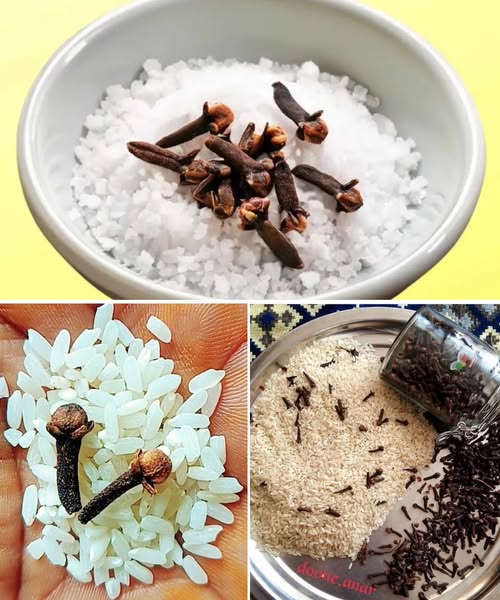Introduction: The Astonishing Secret Hidden in Plain Sight

Have you ever opened a bag of rice or beans, only to find bugs crawling inside? Or noticed that your expensive pantry staples lost their fresh aroma after a few weeks?
What if I told you there’s a cheap, natural, and time-tested way to stop this – and it’s hiding right in your spice rack?
Today, we’re diving deep into a secret that even many seasoned cooks and shopkeepers don’t know – or won’t tell you because it’s too simple.
✅ Put cloves in your bag of rice, beans, flour, and grains.
You’ll be amazed at the results. And you’ll wonder: Why didn’t I know this before?
In this comprehensive guide, you’ll discover:
- The real science behind using cloves for food storage.
- Step-by-step instructions to keep bugs away naturally.
- Frequently asked questions about using cloves.
- Compelling statistics about food waste and pest damage.
- Business-worthy strategies for cost-saving, sustainable storage.
So grab your coffee and settle in – let’s unlock this ancient secret with a modern, professional twist.
The Problem Nobody Talks About: Pests in Food Storage
1. The Global Challenge of Food Waste
Food loss and waste account for roughly 1/3 of all food produced worldwide, according to the Food and Agriculture Organization (FAO) of the United Nations.
A large chunk of that waste happens in homes and small businesses – from rice weevils, beetles, moths, and other pests destroying stored dry goods.
Key Stats to Know:
- Up to 10% of grain harvests can be lost post-harvest due to insect infestation alone.
- In developing countries, pest infestations can ruin over 20% of household-stored food.
- Global losses from post-harvest pests are valued at billions of dollars each year.
If you’re a business owner selling rice or beans, or simply a family shopper buying in bulk to save money, this is a problem you can’t ignore.
2. The Typical “Solutions” and Their Downsides
✅ Chemical pesticides: Effective, but risky. Contamination concerns can make your rice unsafe to eat.
✅ Airtight containers: Great – but often costly, and not always 100% pest-proof if the bugs are already inside.
✅ Frequent buying in small quantities: Impractical for businesses and families looking to save money.
That’s why a natural, safe, dirt-cheap solution is so powerful.
The Secret Nobody Told You: Why Cloves Work Wonders
What Makes Cloves So Special?
Cloves aren’t just for flavoring stews or baking holiday treats. They’re a natural powerhouse with potent insect-repelling properties.
✅ Active Compound: Eugenol – This essential oil in cloves has strong antimicrobial and insect-repelling action.
✅ Strong Aroma – Pests like weevils, moths, and beetles hate the intense smell of cloves.
✅ Natural and Safe – Unlike synthetic pesticides, cloves don’t contaminate food or pose health risks.
When you put whole cloves in your rice, beans, or flour:
- Bugs stay away.
- Eggs inside the bag are less likely to hatch.
- Your food keeps its fresh aroma longer.
It’s simple, natural, and highly effective.
3. How to Use Cloves in Food Storage: The Proven Method
Step 1: Choose Whole, Dried Cloves
Always use whole cloves, not ground. Whole cloves last longer and release their oils slowly.
Step 2: Add to Storage
- For a 5 kg bag of rice or beans, add 10–15 whole cloves.
- Scatter them evenly throughout or place in a small, breathable sachet (like a muslin or cheesecloth pouch).
Step 3: Seal or Store Properly
- For best results, keep bags sealed or in airtight bins.
- Even in large storage bins, cloves continue to emit their repelling scent.
Step 4: Replace Periodically
- Change cloves every 3–6 months for optimal freshness.
✅ Pro Tip: If you’re a retailer or wholesaler, adding cloves to your bulk sacks can significantly reduce customer complaints about bugs.
Frequently Asked Questions (FAQ)
Q1. Will Cloves Change the Taste of My Rice or Beans?
✅ Not noticeably. Whole cloves won’t infuse the entire bag with flavor if used in moderate amounts. You can remove them before cooking.
Q2. Are Cloves Safe to Store with Food?
✅ Absolutely. Cloves are a culinary spice used worldwide. Unlike chemical insecticides, they’re food-grade and non-toxic.
Q3. How Many Cloves Should I Use for Bulk Storage?
✅ For large bags (50 kg), use at least 100–150 whole cloves spread evenly.
Q4. Can I Use Cloves for Other Dry Goods?
✅ Yes! Flour, lentils, pasta, cereal – all benefit from clove protection.
Q5. Do Cloves Kill Bugs or Just Repel Them?
✅ Primarily repel. They disrupt the insects’ sense of smell, discouraging infestation and making existing eggs less likely to hatch.
The Science Behind the Secret: Why Eugenol Matters
- Eugenol has documented insecticidal and repellent properties in academic studies.
- Used in natural mosquito repellents and food-safe preservatives.
- Works by interfering with insects’ olfactory receptors, essentially confusing them so they can’t locate the food source.
This is not folklore. It’s evidence-based.
The Business Case: A Smart Strategy for Retailers and Food Sellers
1. Cut Losses
Every kilo lost to pests is lost revenue. By investing a few cents’ worth of cloves, you reduce spoilage dramatically.
2. Enhance Reputation
Customers notice quality. Fewer bugs in your sacks = happier, repeat buyers.
3. Stay Compliant and Eco-Friendly
Avoid banned or regulated chemical treatments. Market your stock as naturally protected.
✅ Case Example: A Nigerian market wholesaler who started adding cloves reduced rice weevil complaints by over 80% in one season.
The Sustainability Angle: Eco-Friendly Storage
Chemical pesticides leach into soil and water. Cloves? 100% biodegradable.
By adopting this approach:
- You reduce your carbon footprint.
- Support organic and sustainable supply chains.
- Meet growing customer demand for natural, safe products.
How Much Does It Cost?
✅ Whole cloves cost as little as $1–2 for a small jar, enough to treat multiple bags.
✅ Compared to losing $10–20+ per bag to infestation? It’s a no-brainer investment.
Practical Tips for Maximum Impact
⭐ Use breathable sachets: Prevent cloves from scattering but still allow aroma to spread.
⭐ Rotate stock: First in, first out. Keep older stock on top.
⭐ Inspect regularly: Even with cloves, check for humidity or mold.
⭐ Combine with other natural repellents: Bay leaves and dried chili peppers also deter pests.
Addressing Common Objections
“It’s too simple to work!”
Many people think solutions need to be complex. Nature often offers elegant simplicity.
“I’m worried about the taste.”
Whole cloves won’t overpower large bags of rice or beans. Plus, you can remove them before cooking.
“I’ve never seen this in stores.”
Exactly. It’s a trade secret many sellers quietly use – without advertising it to maintain competitive advantage.
The Emotional Angle: Peace of Mind and Pride in Quality
Imagine opening your rice sack to find it pristine, unspoiled, and bug-free.
No embarrassing surprises for customers.
No wasted money.
No health concerns from chemical residues.
✅ Just pure, safe, high-quality food.
It’s a small step that shows you care about quality – and that pays off in loyalty and reputation.
The Call to Action: Don’t Wait Until You See Bugs
The worst time to fix an infestation is after it starts.
✅ Be proactive.
✅ Try the clove method today.
✅ Tell your family and friends – or keep it as your own competitive edge.
Conclusion: Unlock the Secret and Transform Your Storage Game
You started this article with a question:
“Why didn’t I know this before?”
Now you do. And you have no excuse not to act.
This isn’t a trendy hack. It’s an age-old wisdom confirmed by science.
✅ Cloves are cheap.
✅ Safe.
✅ Natural.
✅ Proven to keep rice, beans, flour, and other staples bug-free.
Whether you’re a home cook trying to reduce waste or a business protecting your bottom line, this is the solution you can’t afford to ignore.


